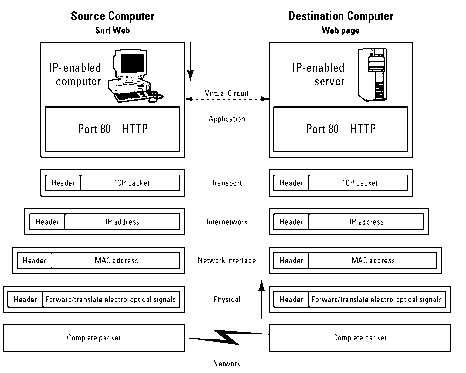Many people marvel at the very thought that the POTS method of placing telephone calls can be replaced by a technology that essentially runs on the computer network. They are also startled by the many new and exciting features that come with VoIP. However, people also question how VoIP can possibly work and are a bit suspicious about whether VoIP can really live up to all the claims.
The answer can be found in the very same model that has been supporting data-only networking since the inception of the Internet more than twenty-five years ago: the TCP/IP model.
Pronounced “t, c, p, i, p,” the model uses a five-layer approach to networking. TCP/IP is adapted to enable it to also support VoIP. TCP/IP has proven to be just as effective with packetizing telephony as it has been for many years with packetizing computer data.
To fully understand VoIP, it pays to know a little about the technical underpinnings that make it work over the network of your choice. In this section, I describe the layers of the TCP/IP model in relation to computer networks. Then I insert into this content the parts that change when TCP/IP supports
VoIP.TCP/IP layers
TCP/IP is first and foremost a group of networking protocols. Protocols are the rules that govern how network traffic gets packaged electronically for transmission over a network. Some TCP/IP protocols are used strictly for data networking, some are used strictly for VoIP telephony, and some are used by both data and VoIP. Each protocol corresponds to one of five possible layers that make up the TCP/IP model:
Application: Special protocols at this layer ensure the quality and deliv-erability of VoIP packets.
Transport: The user datagram protocol (UDP) at this layer transports the VoIP packets from start to finish, which in this case means from caller to receiver and vice versa.
Internetwork: At this layer, IP addressing is added to the packet. Every VoIP phone or computer acting as a VoIP phone gets a unique IP address that routes delivery of VoIP packets to and from the caller and receiver during the life of the call.
Network interface: At this layer, MAC addressing is added to the packet. (The MAC address is supplied by the NIC required for all network devices.)
Physical: This layer converts all packets to electro or electro-optical signals to be carried over the local or external network.
Each layer is associated with one or more protocols. A packet must traverse all five layers: once when the packet is sent and again when it is received.
Basically, the VoIP packet originates with the caller. The packet travels down all five layers on the caller’s side of the network and gets packaged with the correct protocols at each layer. After the packet reaches the lowest layer, the physical layer, it is sent over the network to its destination. When the packet reaches its destination, it makes its way up through the layers and gets unpackaged. When it reaches the application layer of the receiver, the packet is translated into a voice signal that the receiver hears.
TCP/IP differences
TCP/IP protocols are applied a little differently depending on whether you have a traditional data packet or a VoIP packet. Figure 1-1 illustrates the packet breakdown and corresponding layers involved in a TCP/IP network connection for a standard Web application, which uses a traditional data packet.

Figure 1-1:Passing a data packet through the TCP/IP protocol layers.
Note that the transport layer of the packet uses the familiar TCP protocol to construct the packet exchanges between the source computer and the destination computer (in this case, the Web server).
Figure 1-2 illustrates the layered protocol stack shown in Figure 1-1, but this time applied to a VoIP call. Note the header at each layer’s version of the packet (except the application layer). The various headers identify what layer the packet is on during its travel from caller to receiver.
If you compare Figures 1-1 and 1-2, you notice two protocol differences, at the application and transport layers of the TCP/IP model. Other than these differences, a great deal of symmetry exists between voice and data using TCP/IP. That’s why VoIP can behave like a telephone while delivering many computer-related functions.
Application layer differences
The first difference between the VoIP implementation of TCP/IP and the traditional data implementation is in the application layer. In a VoIP call, the application layer utilizes the following three protocols:
‘ NTP: Network time protocol. This protocol enables timing, which helps ensure that the signals are transmitted and received within the proper timeframe to assure quality.
‘ RTP: Real-time transport protocol. This protocol provides end-to-end network transport functions for digital voice signals encapsulated in the VoIP packet.
‘ RTCP: Real-time transport control protocol. This protocol monitors voice signal delivery and provides minimal control functions to ensure the delivery of packets.
All three of the application layer protocols combine, at nanosecond speeds, to deliver VoIP voice packets.
Transport layer differences
The second difference between the traditional data implementation of TCP/IP and the VoIP implementation is in the transport layer. The lion’s share of computer data networking uses the TCP protocol at the transport layer. For VoIP, the transport layer uses UDP, user datagram protocol. (UDP is used also for real-time videoconferencing networks.)

Figure 1-2:Passing a VoIP call through the TCP/IP protocol layers.
TCP is slower than UDP, but it provides guaranteed delivery of its computer data packets. Keep in mind that we are measuring speed here in nanoseconds. Even if it takes a long time for the packets to reach their destination computer, eventually TCP ensures delivery.
Because voice is a real-time application, it is more important that the voice packets get to the receiver as quickly as possible. That is why UDP is by far the hands-down favorite to provide the transport layer for VoIP networks.
